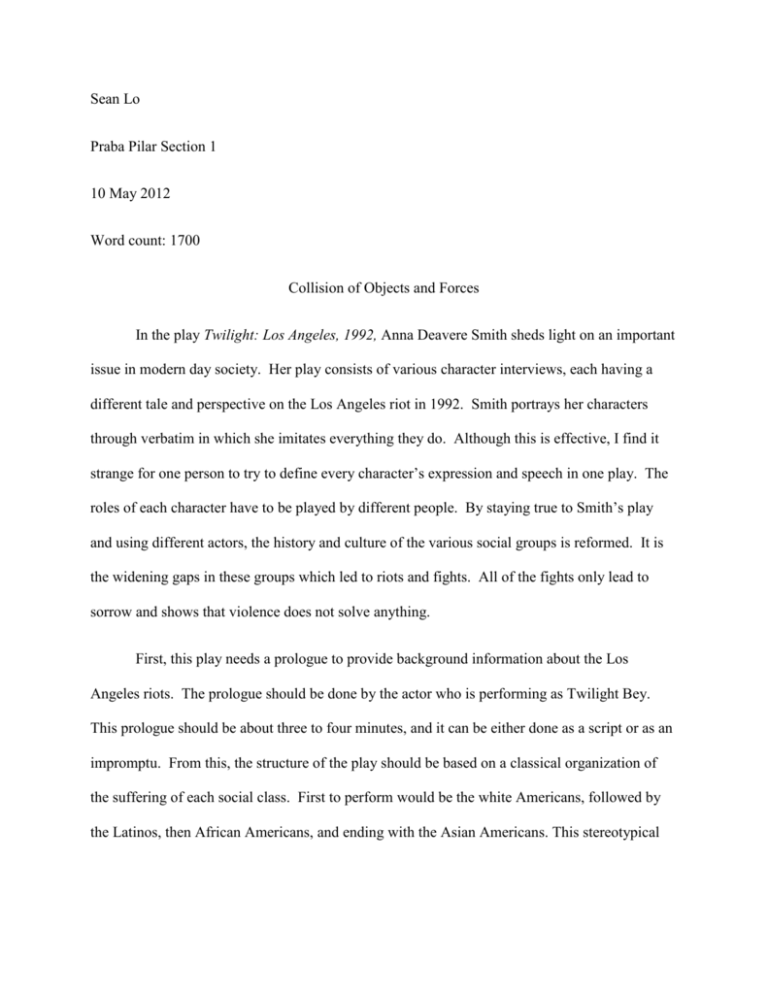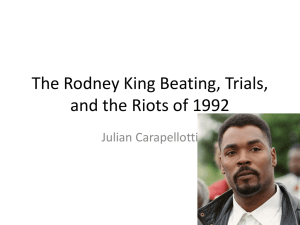File
advertisement

Sean Lo Praba Pilar Section 1 10 May 2012 Word count: 1700 Collision of Objects and Forces In the play Twilight: Los Angeles, 1992, Anna Deavere Smith sheds light on an important issue in modern day society. Her play consists of various character interviews, each having a different tale and perspective on the Los Angeles riot in 1992. Smith portrays her characters through verbatim in which she imitates everything they do. Although this is effective, I find it strange for one person to try to define every character’s expression and speech in one play. The roles of each character have to be played by different people. By staying true to Smith’s play and using different actors, the history and culture of the various social groups is reformed. It is the widening gaps in these groups which led to riots and fights. All of the fights only lead to sorrow and shows that violence does not solve anything. First, this play needs a prologue to provide background information about the Los Angeles riots. The prologue should be done by the actor who is performing as Twilight Bey. This prologue should be about three to four minutes, and it can be either done as a script or as an impromptu. From this, the structure of the play should be based on a classical organization of the suffering of each social class. First to perform would be the white Americans, followed by the Latinos, then African Americans, and ending with the Asian Americans. This stereotypical “class system” was a problem in Los Angles that reflects the causation of the riots which began because of dominance in authority. The opening performance of the night should be Elaine Young, the Real Estate agent. The performer for Elaine Young should be a white female and appear around her thirties. Her costume should be a tight and non-seductive office outfit. On both hands, she should be wearing expensive jewelry and when she speaks; her tone should contain a mixture of seriousness and happiness. Although she is vague representation of white Americans during the Los Angeles riots, she is the perfect portrayal of how ignorant the whites were during the riots. During her interview, Young produces lots of unnecessary commentaries about herself and provides little responses about the riots. For instance, in Young’s interview performance, she comments about “some man [who] wrote…a letter” to criticize her about “…having fun during the riots at Polo Lounge.” (79). She only explains information regarding her fear of the riots which supports why so many of the white Americans knew about the riots but were fearful of becoming involved. This also reveals the weakness of the government in 1992. The “white” government grew fearful of taking appropriate actions in Los Angeles. Eventually, the government sent the military to take care of this problem but they failed to see the widening gap between the social groups. As a result of their action, more riots broke out in Los Angeles and death became popular. Thus, this shows why violence is not the answer to problems in society. Ground reporter Judith Tur should follow after Mrs. Young’s performance. During her performance, a screen should be showing the video from the beating of Reginald Denny, as she speaks to the audience and guides them through the scene. Staying true with the play, the performer should appear to be around fifty; however her performance can be done by the performer of Elaine Young. Her tone should set a sorrowful and disturbing atmosphere in the room. Ms. Tur’s performance is crucial here after Young because not only does her performance reveal footage from the riots, but it is her performance that helps the audience form an opinion on the wrongs and rights of injustice dealt in society. The opinions of the audience should be developing around the time Tur states “Now these women here…are taking pictures of this…This is sick…nobody’s helping him.” (86) Her statement accurately represents a psychological phenomenon in human beings known as the bystander effect. This term states that the chances of someone receiving help from another person are decreased in large groups of people as opposed to being in small groups. Tur’s tone during her performance should be a mixture of being shocked and surprised. This performance helps the audience reflect on what they would do if they were witnessing this event. Again, this draws back on the idea of how violence does not solve social problems. Using violence would only lead to more violence in the end with people getting hurt. Immediately following Tur’s performance would be Reginald Denny’s interview to help the audience understand the cruelty of humans. His performance would increase the effect of the atmosphere from Tur’s performance through his innocent tone and tragic story. The interview with former senator Bill Bradley should be used to finish the interviews of the white American class. His performance should be played as a speech because it is more appealing to the audience since he is a man of “high authority.” Bradley should be dressed like a Congressman and his tone for the performance should be serious. He opens the general issue of racial inequality in America with a story about his African American friend. His performance ends with a call to action as he tries to rally the audience and try to help him make a change. Bradley wants “the application of law before in which we are all in theory equal” to be held true in society and carried out by the people. (153) His last remarks call for the people to stand up against the tyranny of inequality in America. Bradely’s performance may seem to only appeal to the white audiences when he speaks of equality; however, his speech is meant for all social groups which creates a sense of irony. The irony helps develop the ambition of his character by making him hold truth to his words. Bradley’s performance unifies the social groups by asking for no violence to be involved in peace making. He has seen the consequences of enforcing violence and does not want anyone else to get hurt. Josie Morales will set the stage for the interview with the African American social group. Although she is Latina, she is a witness of the Rodney King (an African American man) beating. Latinos were similar to African Americans during the riots; they both hated cops and they robbed stores. Morales’s performance should be done by a Latina woman around her thirties, in a living room setting that is being used as an interrogation room. As a witness of the horrific beating, every word she speaks should be carried by an uneasy tense feeling as if she has nightmares about the event every night. Morales’s morals on injustice appear when she tells her husband during the viewing of the beating “We have to stay here and watch because this is wrong.” (50) Here, Morales is showing the audience that the world needs people to stand up against injustice. If no one chooses to stand firm and fight for others, then later in the future, the injustice will grow and affect everyone. This reiterates the issue of violence and how it solves nothing if another force is used to disturb it. Morales’s performance is a symbol of hope for the minorities, which perfectly transitions over to the African American’s performances. Angela King will take the stage following Morales’s performance. The performer has to be an African American lady around her forties wearing a long black dress. She will be seated in the same living room from Morales’s performance and be knitting while she speaks and cries about the beating of Rodney King. Also, a video of the Rodney King beating should be playing silently beside her as she speaks. Her interview dives into the heart of the audience when she discusses the beating done to Rodney. Her statement “I recognized him layin’ there on the ground…And he looked just like his father” reiterates the sad images from her past into her mind which evokes the emotion of sadness (127). King’s performance will keep the audience wondering about how the choices that they make in life will affect social injustice and raise the question of what should be done to rid injustice in society. Furthermore, her performance reinforces the idea of how justice cannot be achieved through violence. Using violence will only create more violence and thus repeat in a never ending cycle. King’s performance represents the tragic truth of every character’s performance. By having the characters speak the truth, the message of the play grows onto the audience as the play draws to a close. The ending performance of the play should begin with a mixed performance of Mrs. Young-Soon Han and Mrs. June Park. Mrs. Han’s performance talks about how the Korean became pariahs of society while the African Americans received aid. On the other hand, Mrs. Park’s performance reveals the death of her husband because of the African American’s violence. An elderly Asian female performer can play both roles by first speaking through Mrs. Han and then slowly incorporating Mrs. Park into the performance. Setting it up this way allows the audience to rejoice with the African American group’s resolution, but also feel sympathy for the Korean people for being the receiver of the African American’s pain. Again, the idea of violence is repeated and teaches how using violence does not solve issues in society. This would set up the last performance of the play which is performed by Twilight Bey. The performer doing the prologue should be playing this part as well. His last remarks will leave the audience reflecting on the events in the play. Plays share an important message about the world to audiences. My intention for the directing this version of the play was to reveal that fighting will not result in peace. Fighting will only bring forth more violence and death. This was apparent in the social classes of Los Angeles in 1992 which caused hundreds of deaths every day in the city. Ultimately, the wide gaps between the social groups were forced closed through violence. Humans can only hope there won’t be a use of violence in order to establish peace in the future









